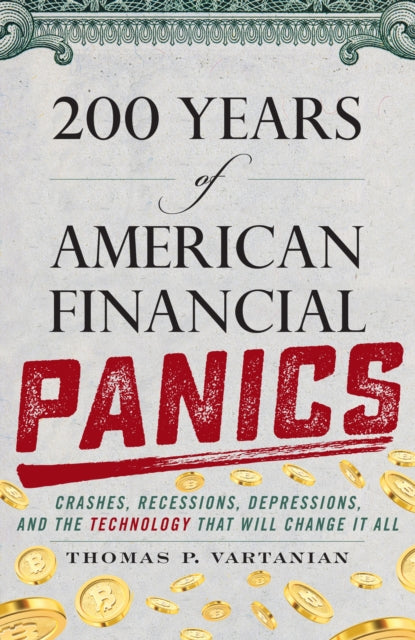Thomas P. Vartanian
200 Years of American Financial Panics: Crashes, Recessions, Depressions, and the Technology that Will Change It All
200 Years of American Financial Panics: Crashes, Recessions, Depressions, and the Technology that Will Change It All
YOU SAVE £5.72
- Condition: Brand new
- UK Delivery times: Usually arrives within 2 - 3 working days
- UK Shipping: Fee starts at £2.39. Subject to product weight & dimension
Bulk ordering. Want 15 or more copies? Get a personalised quote and bigger discounts. Learn more about bulk orders.
Couldn't load pickup availability
- More about 200 Years of American Financial Panics: Crashes, Recessions, Depressions, and the Technology that Will Change It All
Throughout 200 years of American history, financial crises have repeatedly occurred due to various factors such as tariffs, government intervention, and the Federal Reserve's loose monetary policies. This book offers solutions to avoid these crises and emphasizes the importance of renovating the formula for financial oversight in the country.
Format: Hardback
Length: 460 pages
Publication date: 15 July 2021
Publisher: Prometheus Books
In a comprehensive historical account spanning 200 years, from 1819 to the economic challenges of 2020, Thomas P. Vartanian delves into the intricate factors that have led to numerous financial crises in the United States. Through meticulous research and analysis, he unravels the causes and consequences of these crises, offering valuable insights into how to prevent such crises in the future.
The book begins by examining the financial panics that occurred in the early 19th century, notably the collapse of 1819, which was facilitated by the imposition of tariffs and the creation of numerous poorly regulated, undercapitalized state banks. The author argues that these factors created an unstable financial system that was vulnerable to shocks and crises.
The next chapter delves into the depression of 1893, which was caused by government battles over the preeminent method of exchange, gold, silver, or paper money. The author argues that the uncertainty surrounding the currency system created the perfect conditions for a economic downturn.
In the 1920s, the Federal Reserve kept interest rates low to assist central banks in England and France, leading to an overheated stock market in the United States. However, when the stock market crashed in 1929, it triggered a global economic crisis that lasted for several years. The author argues that the Federal Reserve's actions contributed to the severity of the crisis.
The roots of the Savings and Loan (S&L) crisis in the late 1980s can be traced back to 1966, when Congress and states imposed artificial caps on deposit and mortgage interest rates to encourage greater home ownership. The author argues that these policies created an unsustainable housing bubble that eventually burst, leading to the S&L crisis.
In the 1990s, the government pressured banks to offer mortgages to low and middle-income borrowers, while the Federal Reserve engaged in loose monetary policies. This combination of factors led to the greatest economic crisis since the Great Depression. The author argues that the government's intervention in the financial market created a moral hazard, encouraging banks to take excessive risks.
The book also explores the impact of technology on financial crises, particularly the rise of artificial intelligence and cryptocurrencies. The author argues that these technologies have the potential to disrupt the traditional financial system, but they also pose new risks and challenges.
One of the key themes of the book is the need for a more effective and robust system of financial oversight. The author argues that the pyramid of governmental financial oversight deployed to foster economic safety has been turned on its head in our current era, making our system of financial oversight less effective and more susceptible to financial crises. He suggests that policymakers should focus on promoting financial stability and resilience rather than simply trying to prevent crises.
The book also offers practical solutions for avoiding financial crises in the future. The author suggests that policymakers should implement regulations that promote transparency and accountability in the financial system, strengthen the regulatory framework, and promote greater financial literacy among consumers. He also advocates for a more diversified and resilient economy, which can better withstand shocks and crises.
In conclusion, 200 Years of American Financial Panics is a must-read for anyone interested in understanding the history and causes of financial crises in the United States. Through comprehensive analysis and insightful solutions, the book provides valuable insights into how to prevent such crises in the future. It is a timely and important contribution to the field of finance and economics.
Weight: 814g
Dimension: 165 x 237 x 45 (mm)
ISBN-13: 9781633886704
This item can be found in:
UK and International shipping information
UK and International shipping information
UK Delivery and returns information:
- Delivery within 2 - 3 days when ordering in the UK.
- Shipping fee for UK customers from £2.39. Fully tracked shipping service available.
- Returns policy: Return within 30 days of receipt for full refund.
International deliveries:
Shulph Ink now ships to Australia, Belgium, Canada, France, Germany, Ireland, Italy, India, Luxembourg Saudi Arabia, Singapore, Spain, Netherlands, New Zealand, United Arab Emirates, United States of America.
- Delivery times: within 5 - 10 days for international orders.
- Shipping fee: charges vary for overseas orders. Only tracked services are available for most international orders. Some countries have untracked shipping options.
- Customs charges: If ordering to addresses outside the United Kingdom, you may or may not incur additional customs and duties fees during local delivery.


